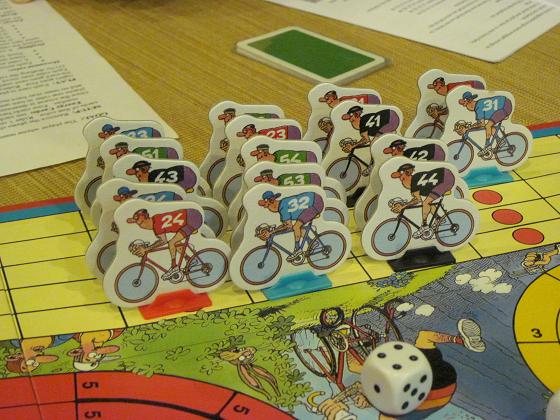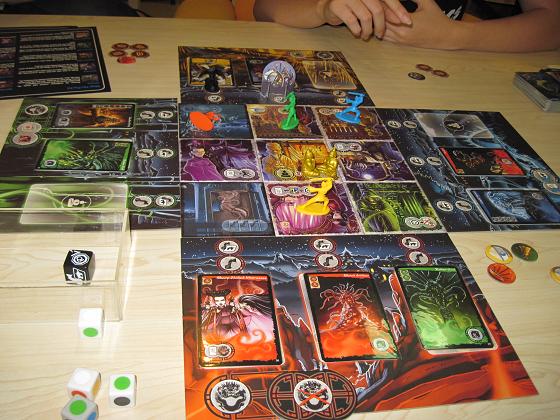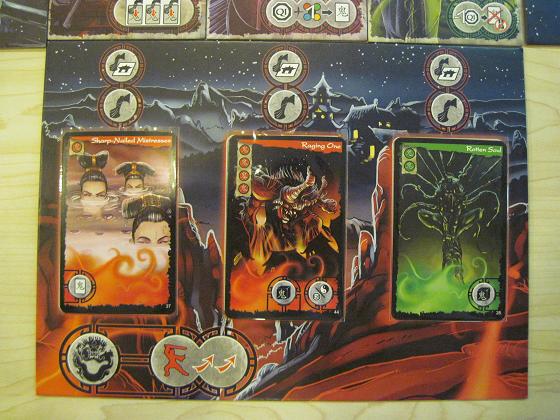
Shan’s eldest niece is currently staying with us and decided to go with us on our usual Saturday evening outing to CarcaSean, so Sean had to think of some simpler games for our session. On the one hand, this meant that we couldn’t play some of the meatier fare that we were looking forward to, such as Le Havre, but then it was also a chance to play some stuff that we ordinarily wouldn’t have chosen for ourselves.
We started with Um Reifenbreite, a game that I was very surprised to learn was first published in 1979. It apparently even won the Spiel des Jahres in 1992. I guess standards weren’t very high back then. It’s basically a roll and move game in which each player controls a team of four cyclists in a race. The track is divided into spaces and rolling a pair of dice lets you move a number of spaces equal to your result. To make it more of an actual game, you also get a hand of energy cards which can be played in lieu of rolling a die to let you move spaces equal to the card’s value and there’s a rule allowing riders immediately behind someone to trail along his wake without needing to roll dice.
Rolling a seven forces you to draw an event card which adds even more randomness to the game. Sean kept threatening a fall event which would cause all of the riders to fall en masse but most of our events were actually good ones. Some spaces on the track are considered as going uphill and you need to deduct a number printed on the space from the spaces you’re allowed to move. When going downhill, you add the printed number instead. Each cyclist is awarded points according to the order that they pass the finish line and the overall winner is the player whose team has scored the most points. There’s really not much going for this game, and I’m not saying that just because I came dead last. While there are some decisions to make (how should I place my riders at the start? When should I play energy cards? Should I trail behind another rider or strike out on my own?) it’s still basically a dice fest. Pushing around the little cardboard cyclists is kind of amusing, but watching something like, say, Les triplettes de Belleville is way more fun.

The next game we played was Ghost Stories, a cooperative game in which the players control Taoist priests trying to defend a village from a supernatural invasion. As my wife remarked, this game is clearly inspired by the cheesy horror films that used to be made in Hong Kong. Your priests for example can collect coloured tokens that can be spent to gain automatic successes against the appropriate ghosts, and these tokens represent things like mirrors, bowls of rice, joss sticks etc. Even the main villain is called an incarnation of Wu Feng, which is about as schlocky as you can get.
The village is composed of a grid of nine large tiles arranged in a 3 x 3 grid. Each of these tiles provide a special ability, ranging from resurrecting a dead player to teleporting ghosts and players around the map. Each player then adds his board to one side of the grid, which has spaces for playing ghost cards on and handily reminds you of the special powers each player has. Life is represented by Qi tokens and there are also Yin Yang tokens which can be spent to activate a location’s special ability without being there.
At the beginning of each player’s turn, he draws a ghost card and tries to play it on a board matching the card’s color. Like Race for the Galaxy, Ghost Stories makes heavy use of iconography to indicate what each card does. These effects include forcing the player to draw a second ghost card when it comes into play, reducing the number of dice the players may roll when attempting an exorcism and granting rewards to a player when he destroys the ghost. Each ghost also has toughness represented by the number of successes of the appropriate color needed to exorcise. Players roll a set of dice with the colors on their faces to try to match them to exorcise ghosts.
In the scenario we played, Sean picked one card representing an incarnation of Wu Feng and placed it ten cards from the bottom of the ghost deck. This meant that we had to survive until the big baddie appeared and needed to destroy him before the deck ran out. We would lose if all players ran out of Qi or if one entire row of the grid became haunted, i.e. turned face down and deactivated by ghosts. My character’s power was that he could both attempt to exorcise ghosts and activate a location’s ability while the other players needed to choose to do one or the other. I think I ended up whacking more ghosts than any other player.
Once again, this is a game with an extremely high dose of luck. Sean failed several times to exorcise a ghost which only needed one success to kill even though his character could roll four dice! Shan’s character died about two thirds of the way through the game and no one could spare a turn to go resurrect her. We did eventually win but I suspect that this was only possible because we “forgot” to draw ghost cards a few times. Actually, according to this FAQ that I later read, we got several rules wrong, all to our advantage, so we should have been stomped.
My experience with this game matches those for Arkham Horror and Pandemic so I guess pure cooperative games aren’t really for me. There’s a certain puzzle-solving aspect in these things that’s kind of fun but I don’t really see the appeal of cooperatively solving them. It’s just so easy for the one person who’s the most analytically inclined to take the lead and everyone else just goes along. I notice that this game has a number of smallish expansions for it and quite a following. Like Arkham Horror which similarly has lots of expansions, I wonder how many people are buying these things just to play them solitaire?
The last game we played was TransEuropa but I neglected to take any photos of it. While it has the simplest and most easily explained rules of the three games, it’s easily the deepest and most strategically interesting. The board is a map of Europe and like the Ticket to Ride games, you draw destination cards and must connect them using a rail network. The difference is that there’s only one rail network and each turn a player may place two rail pieces on normal areas or one piece on difficult terrain. This means that you need to guess where other players are going and try to piggyback on their building efforts, while trying to place your own pieces in such a way as to minimize any help you might give to them.
Overall, while I was glad to be able to play all three games, the only game I’d be willing to play again would be TransEuropa. It’s enough to experience the other two games once to understand what they’re about, but I probably won’t enjoy repeated sessions of them very much. I am curious about other racing games and wonder if all of them use similar roll and move mechanics. I liked the photos of games like Formula De that I saw but I haven’t had a chance to play it yet. My niece liked Ghost Stories best however, so I suppose there is a market for such things.

3 Responses to “Um Reifenbreite / Ghost Stories / TransEuropa”
I like Um Reifenbreite the best! Probably because i win :p
I think it similates the real race well… If you lead all the way breaking the wind, you’ll be tired and fall behind.
Maybe because we only play “half course”. The advance game and full course should be more strategic. But like Formula De and Formula De Mini, Formula De is just too long…
We play Ghost Stories wrong :p
We actually lost the game after rolling the last curse die .
Trackbacks
Leave a Reply